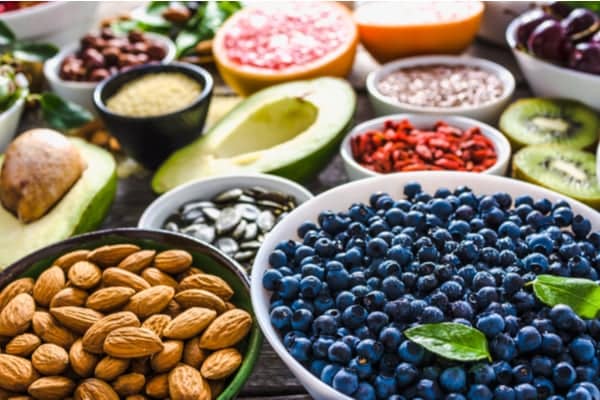An anti-inflammatory diet is recommended to people to prevent different health issues from arising or as part of a treatment regimen for a range of chronic conditions, from a permeable gut (leaky gut) to chronic back pain.
However, there are few research-backed resources available that can guide people on what an anti-inflammatory diet actually consists of.
Luckily, some researchers have developed important resources for health professionals to help guide their clients and patients on making dietary and lifestyle choices that fight against inflammation and could have a significant positive impact on their health.
Making anti-inflammatory dietary choices shouldn’t be confusing or complicated. At AFPA, we’ve reviewed the most up-to-date research and resources available on anti-inflammatory diets to empower coaches and clients alike.
In this article, we provide you with information about inflammation in general and guide you through easy-to-understand and transferrable resources that can help you promote the health of your clients.
What Is Inflammation?
Inflammation is the immune system’s natural response to an irritant. An irritant could be bacteria that enters the body through a wound, a splinter, or effects of chemicals in the body.
When the irritant enters the body or the irritant is detected by the body, the area will become inflamed as immune system cells and chemicals rush to the area. Depending on the type of irritant that is detected, different cells may be involved.
Some of the cells involved in immune system response are macrophages, neutrophils, and lymphocytes. These cells release different inflammatory mediators, like the hormones bradykinin and histamine, pro-inflammatory cytokines, and vasoactive amines and peptides (protein building blocks).
What is important to know about the substances mentioned above is that they cause the blood vessels to dilate. Dilation allows more blood to reach the tissue, meaning that substances that can help defend the body from infection or injury can reach the area faster.
As a result, the area becomes red and inflamed, and, if the injured area is close to the surface, it becomes hot. The chemicals that are released also release pain signals to the brain. If an area hurts, you will naturally try to protect it from further injury.
If the immune system is successful at protecting and healing the area, inflammation will go down and the area will no longer hurt.
However, in some cases, inflammation is not helpful to the body. Some conditions, called autoimmune diseases or chronic inflammatory diseases, attack the body’s cells by mistake. This causes inflammation that is harmful to the body. Some of these diseases include rheumatoid arthritis, psoriasis, and inflammatory bowel diseases like IBS and Crohn’s disease.
In other cases, chemicals that circulate in the body due to lifestyle choices and emotions are recognized by the body as irritants and will have an inflammatory response until the chemicals are no longer circulating in the body.
Chronic inflammation is also called non-resolving inflammation.
Types of Inflammation
Inflammation can be divided into two general types.
Acute inflammation: starts rapidly, is often severe, but usually clears up within a few days. This type of inflammation occurs due to trauma, infection, or the ingestion of toxins, among others. Pain, redness in the area, a surface area that is hot to the touch, or acute pneumonia are some symptoms of acute inflammation.
Chronic inflammation: occurs slowly and lasts several months or years. The cause of chronic inflammation is variable, from extreme physical trauma to autoimmune disease to other chronic diseases. When people talk about an anti-inflammatory diet, they are generally referring to a diet that can help mediate chronic inflammation.
Causes of Chronic Inflammation
According to the World Health Organization, chronic inflammatory diseases are the most significant cause of death in the world.
Chronic, persistent, or non-resolving inflammation can result from:
- The inability of the body to remove the bacteria, fungi, or virus that is causing an infection
- Exposure to an irritant or foreign material over several weeks, months, or years that cannot be removed by the body
- An autoimmune disease like rheumatoid arthritis or lupus
- A defect in the immune system cells
- Recurrent episodes of acute inflammation
- Exposure to or production of inflammatory chemicals like increased free radicals, uric acid crystals, oxidized lipoproteins, homocysteine, and others.

Get Your Free Guide to the Top 50 Anti-Inflammatory Foods
What Conditions Are Linked to Chronic Inflammation?
Inflammation is brought on by different conditions, lifestyles, and illnesses.
Having chronic inflammation can increase your risk for a range of different diseases. In fact, inflammation is present in so many conditions that some experts are referring to inflammation as the unifying theory of disease.
In short, inflammation and chronic illness engage in a vicious cycle that can be difficult to break unless a person commits to making significant lifestyle changes.
Some conditions linked to chronic inflammation include:
- Obesity
- Stroke
- Heart disease
- Atherosclerosis
- Chronic pain
- Type 2 diabetes
- Chronic obstructive pulmonary disease
- Autoimmune diseases
- Cancer
- Alzheimer’s disease
- Fibromyalgia
- Arthritis
- Asthma
- Erectile dysfunction
- AIDS
- Infection
- Irritable bowel syndrome
- Depression
- Anxiety
An Anti-Inflammatory Diet: The Basics
Before we get into the generalities of an anti-inflammatory diet, we want to highlight an important note about the term “diet.”
Popular culture has transformed the word “diet” into meaning depriving yourself of foods you normally enjoy with the goal of losing weight, gaining muscle, or achieving some other particular physique. From a food and nutrition standpoint, the word diet refers to any pattern of eating. In other words, everyone is constantly “on a diet,” but those eating patterns differ significantly from one to another. Some diets may promote health, while others may cause health issues.
The anti-inflammatory diet refers to a diet that contains foods that actively fight inflammation while leaving out foods that are known to cause inflammation. These foods usually contain at least one chemical with antioxidant and anti-inflammatory properties in significant quantities. These may include dietary polyphenols, phenolic acids, flavonoids, and proanthocyanidins, among others.
The foods richest in these components are fruits, vegetables, grains, spices, and herbs.
Equally important as the food to include are the foods to avoid because they cause a pro-inflammatory response in the body. These include:
- Excessive amounts of meat
- Refined grain products
- Foods high in sugar
- Foods high in artificial preservatives and sodium
Unfortunately, research shows that the typical American diet is high in pro-inflammatory foods and low in anti-inflammatory foods.
From a wider point of view, an anti-inflammatory lifestyle refers not only to diet but also to exercise and lifestyle decisions like avoiding smoking and alcohol and managing inflammation-promoting conditions like stress and anxiety.
The Two Main Principles of an Anti-Inflammatory Diet
An anti-inflammatory diet can be described by two main principles. An anti-inflammatory eating pattern should:
- Focus on eating whole, plant-based foods rich in healthy fats and phytonutrients like antioxidants
- Maintain a stable blood-sugar response, since chronically high blood sugar (blood glucose) can spur inflammation
The Anti-Inflammatory Diet Guidelines
The concept of a “food pyramid” can be a little controversial. If you’ve followed recent USDA guidelines, you’ll notice they no longer use a food pyramid but instead MyPlate to inform people about healthy eating patterns. The plate helps to inform people about what your plate should look like to ensure your nutrient needs are met by your diet.
However, the term “anti-inflammatory plate” can be confusing, too. It suggests that there is an actual plate that can fight inflammation. That is why researchers and dietitians tend to stick to the “food pyramid” as a food education resource for the anti-inflammatory diet.
The Anti-Inflammatory Food Pyramid
The researchers Rondanelli, et. al, developed an anti-inflammatory food pyramid based on the principles described above. The food pyramid is characterized by recommending portions of food groups that provide significant amounts of anti-inflammatory and antioxidant agents.
The Anti-Inflammatory Plate
The anti-inflammatory plate is best represented by Harvard Medical School’s Healthy Eating Plate. It is a slight variation of the USDA MyPlate. It focuses on being more specific about food choices, like choosing whole grains and lean and plant-based protein.

Main Takeaways
Below, we summarize the most important takeaways from this article:
- Acute inflammation is the body’s healthy response to an irritant.
- Chronic inflammation occurs when the body is unable to successfully remove an irritant or recognizes a natural part of the body as an irritant.
- Chronic inflammation is directly linked to an inflammatory lifestyle and causes a range of chronic diseases.
- The typical American diet is pro-inflammatory.
- Anti-inflammatory foods include plenty of fruits, vegetables, whole grains, and lean or plant-based proteins, and foods that regulate blood glucose.
- Pro-inflammatory foods to avoid include red meats, refined grains, and processed foods.




